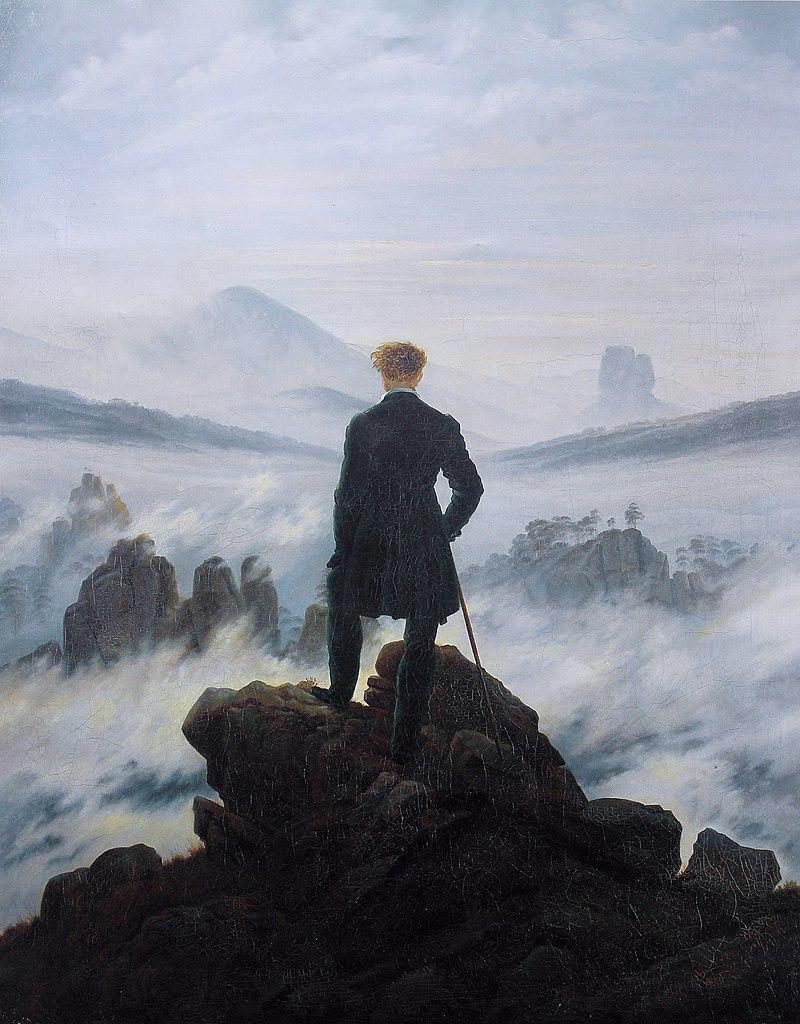Wanderer Above the Sea of Fog was painted in 1818 by German artist Caspar David Friedrich. Its perfectly captures the feeling of the sublime which was a prominent theme during the romantic period. Merriam-Webster Dictionary defines the sublime as “tending to inspire awe usually because of elevated quality (as of beauty, nobility, or grandeur) or transcendent excellence.” I would add that something that is sublime borders on the edge of fear, or even death, but not quite reach those points of dread or injury. It makes you realize the power, greatness, and grandeur of the object next to your own smallness and fragility. Something may be sublime, but the sublime is more of a feeling one experiences. That feeling of realizing how small you are in the vast universe is sublime. Sitting on the edge of a cliff or mountain with your legs dangling off the side, realizing that you are inches away from death; that is sublime. In a journal article by Miguel Angel Gaete, he said, “The sublime entails powerful conceptual associations such as the infinite and the limitless, together with a series of overwhelming feelings that they can elicit in those who experience it” (59). If you have ever seen the Grand Canyon in Arizona, then you are likely familiar with the feeling of the sublime. Wanderer Above the Sea of Fog falls closely in line with the latter example. It depicts a man standing on the of a cliff overlooking a valley filled with fog. The height of the cliff is not immediately realized, until you see how small the trees are on the right side of the painting. The man in the painting seems to be reflecting on something important, and the fog suggests that there is much that is shrouded in mystery for this man. Mystery and the unknown are closely related to the sublime, as they can invoke feelings of fear, being small, and being powerless. This is true when thinking about the vastness, mystery, and unknown of space, and the same is true for the ocean. Gaete adds to this point by saying “Thus, just the same that in the ocean we can only estimate the enormous richness of forms below the surface; in this painting, spectators glimpse only a little part of nature” (61). The sky and the ocean are often associated with the sublime much in part for how little we know about them, and also them being large and powerful forces of nature that answer to no man. This is in line with the Romantics’ strong focus on nature. A place that is often associated with the sublime and has often been the subject of paintings is Mont Blanc, a mountain in the Alps in northern Italy. Its parent peak is Mount Everest. Mont Blanc due to its sheer size is considered to be sublime. It is after all the tallest mountain in western Europe. It is the place where Frankenstein confronted his creature in Mary Shelly’s novel. Imagining those two speaking on top of Mont Blanc invokes the same feeling as seeing the man in Wanderer Above the Sea of Fog standing on the edge of a cliff. These two examples are often used when discussing the sublime in Romanticism.
Gaete, Miguel Angel. “From Caspar David Friedrich’s Wanderer above the Sea of Fog to the ICloud: A Comparative Analysis between the Romantic Concept of the Sublime and Cyberspace.” Gale Literature Research Center, Vishvanatha Kaviraja Institute of Comparative Literature and Aesthetics, 2020, https://go-gale-com.ezproxy.uvu.edu/ps/i.do?p=LitRC&u=utahvalley&id=GALE%7CA643530332&v=2.1&it=r&sid=ebsco.


